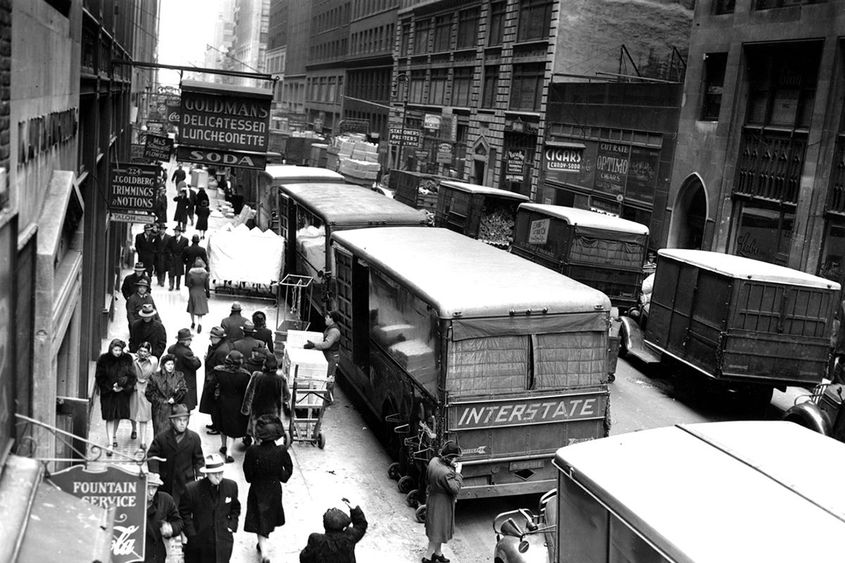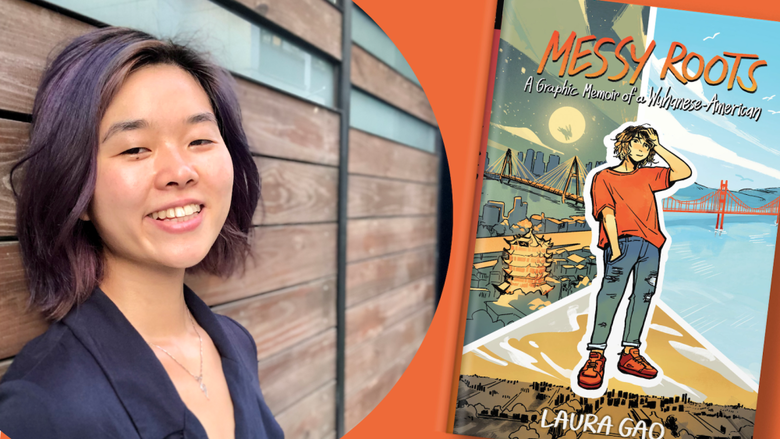
New York's Garment District in the early 1940s.
MIDDLETOWN, Pa. – In 1949, International Ladies Garment Workers Union organizer William Lurye was stabbed to death in public by mob assassins. This event and its aftermath are at the center of “Murder in the Garment District: The Grip of Organized Crime and the Decline of Labor in the United States,” a new book by Penn State Harrisburg faculty Catherine Rios, associate professor of humanities and communications, and David Witwer, professor of history and American studies. The book, which was named to The New York Times’ recommended summer reading list, delves into corruption, coercion and crime and its effects on American organized labor, as well as the country’s complicated relationship with organized labor.
“Lurye's murder occurred in broad daylight, in the midst of the busiest stretch of the New York Garment District, and it was understood at the time as a brazen example of organized crime's ability to commit acts of terrorism to stymie organized labor in favor of the crooked employers who hired these racketeers to protect their businesses from union organizers,” Rios explained. “As the book describes, there were similar acts of violence against labor leaders in this same era, involving other unions, and in other cities, across the U.S. and that despite labor's growth in this era, the state — in the form of local police, prosecutors, and the FBI — took no real steps to bring the perpetrators to justice.”
Witwer said that this was because of the low status of union officials and the rampant police corruption of the era. “As a result, union leaders operating in particular urban sectors and particular industries, such as NYC's garment industry, had no choice but to reach some type of accommodation with organized crime. Lurye's case is a perfect example of this pattern,” he added.
The book also follows the circle of individuals involved in that case to describe the political and economic context in which this history unfolded. “The book shows the way that corruption was not specific to unions, but was an accepted part of the economic landscape,” Rios said. “Also, organized crime was not an alien, invasive presence in these sectors, but instead was well-accepted by employers and understood to provide types of services that many employers wanted.”
The topic of labor unions is close to Witwer and Rios who both grew up in working-class households.
Witwer, who is serving as the 2020-21 Penn State Laureate, also spent some time in France as an undergraduate during a time of labor turbulence in the country. He said he was fascinated by how differently those strikes played out in that country compared to what his experience taught him would have happened in the U.S. He also worked for two years in the Labor Racketeering Bureau of the New York County District Attorney's Office as part of a task force investigating organized crime's role in the New York City construction industry.
“I spent two years on a case involving a local branch of the Carpenters Union whose officers were controlled by the Genovese Crime Family,” he said. “Our efforts led to convictions for several corrupt union officials, this was all part of a larger history of corruption, interrupted by periodic investigations that stretch back to the late 1800s. When I went to graduate school, that was a subject I wanted to explore further.”
Rios’ writing influences are drawn from her background and early work experiences, where she saw first-hand what happened when families did not have workplace protections and faced exploitation. “This made me keenly interested in stories where individuals had to contend with overwhelming systemic challenges,” she said.
She explores these themes in her fiction and screenwriting, including an earlier collaboration with Witwer, written while earning her master of fine arts at Columbia University’s screenwriting program. Based on Witwer’s research, the story, which details the domestic impact of corruption and crime, revolves around a working-class prohibition era character whose illegal liquor distribution network pits him against organized crime boss Al Capone and the political machine that colluded with the Mafia.
Later, as Witwer was collecting research for another of his books, Rios began seeing similar patterns set within a tense and complex political structure, with individual characters who had to navigate their personal codes within a corrupt system. From this work she developed the screenplay, “Pay Dirt,” a fictional dramatic treatment of the same research as “Murder in the Garment District,” that focuses on the impact for individual characters who are faced with those dilemmas. “When it came time to write the book, I believed that David's research on corruption and its impact needed to reach an audience beyond academia, and the collaboration came from that intention,” she said.
The two spent 10 years researching for the book, including reading FBI case files and the private notes and papers of contemporary investigative journalists. The book begins in the Garment District of mid-century New York, where more than 80% of the nation’s dresses were produced. It then transitions to the national stage, where congressional anti-corruption hearings transfixed the nation and helped tarnish the reputation of American unions forever.
“The book describes how that pattern of accommodation left organized labor open to political attack in the late 1950s, when anti-union conservatives cited examples of it to justify efforts to impose new legal limits on unions, making it harder for them to organize,” Witwer said.
According to Witwer, the scandals that emerged during this time, cemented via the news media and later film dramatizations – such as “On the Waterfront” and “The Irishman,” have “tarred the labor movement in general with a nefarious reputation for corruption, a reputation that hobbles its ability to play a bigger role even today.”
“These topics have historically been the subject of dramatic, high profile investigations, often spurred by groups opposed to organized labor, which in turn have received extensive coverage in the news media, and then often dramatized for film and television. These investigations also draw on the public's fascination with organized crime. But in addition, the public's interest reflects the existence of real corruption in some elements of the labor movement, and that corruption, in turn, is scandalous since it betrays the core mission of unions to protect the interests of vulnerable workers.”
In the book, Witwer and Rios assert that what was going on in labor unions was not unique at the time. America was experiencing widespread corruption in the mid-20th century that was accepted by many sectors in society and fostered the growth of organized crime.
“Previous accounts, based on true crime genre books and movies, depict organized crime as a kind of alien presence linked to particular ethnic groups and portray corruption in this era as a problem unique to organized labor,” Witwer said. “However, in this era, for instance, gambling was illegal, but still quite common in the form of illegal bookies and street lotteries. Police practices reflected public tolerance for gambling, and as a result, police corruption was rife in big city police forces, with organized crime groups managing the systemic payoffs that allowed bookies and street lotteries to operate essentially in plain sight. Similarly, a range of business types engaged in endemic forms of corruption, to manage competition or to gain untoward advantages, and these conditions, too ,tended to offer a role to organized crime.”
Witwer and Rios note in their book that because of these historical corruption scandals, today’s labor organizing efforts have suffered greatly.
“Past corruption scandals have provided ammunition for anti-union forces to push through legislation such as the Landrum-Griffin Act of 1959 that made union organizing more difficult, fostering the steady decline of union organization since the 1960s,” Witwer said. “The scandalous reputation of labor is also often cited by groups seeking to oppose union efforts to organize today. The new employee orientation videos shown to workers in some of the country's largest employers emphasize the history of corruption scandals in labor as a reason why workers should not consider joining a union.”
“These are narratives that serve various political and social agendas, and they end up detracting from or cloaking the fundamental goals of organized labor that aim to empower workers and protect them against exploitation,” Rios added.





